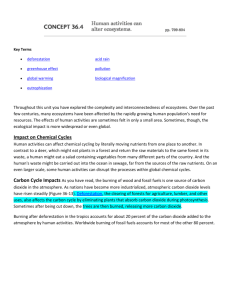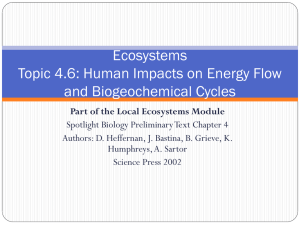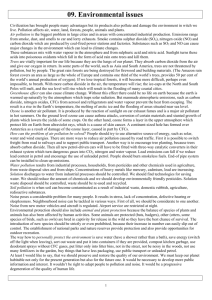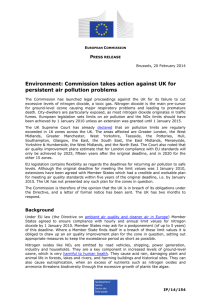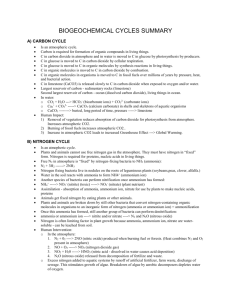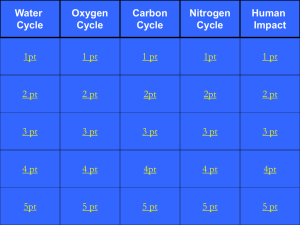File
advertisement
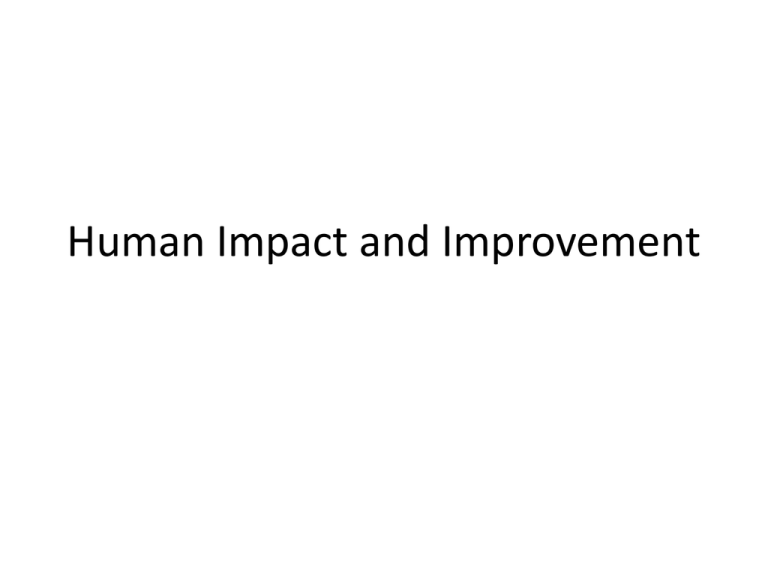
Human Impact and Improvement Water Cycle Water Cycle Processes • Precipitation: water moves from atmosphere to Earth’s surface • Evaporation: water moves from Earth’s surface to atmosphere • Runoff: water moves to lowest point, due to gravity • Infiltration: water seeps through soil to become groundwater • Transpiration: water evaporates from leaves • Condensation: water vapor cools and condenses to form water droplets that make clouds Carbon Cycle Carbon Cycle Processes • Photosynthesis: removes carbon dioxide from atmosphere • Aerobic and anaerobic respiration: adds carbon dioxide to atmosphere • Burning: adds carbon dioxide to atmosphere • Consumption: when an animal eats another organism, transferring carbon • Decomposition: removes carbon from dead organisms and returns it to the soil • Diffusion: transfers carbon dioxide between atmosphere and water Nitrogen Cycle Nitrogen Cycle Processes • Nitrogen fixation: bacteria, algae or lightening convert nitrogen gas into ammonia • Nitrification: bacteria convert ammonia to nitrates • Nitrogen uptake: plants absorb nitrogen (nitrates) from the soil to make DNA and Proteins • Decomposition: removes nitrogen from dead organisms and returns it to the soil • Denitrification: bacteria transfer nitrogen from soil to atmosphere Human Impact on Carbon Cycle • Burning of fossil fuels leads to increased levels of carbon dioxide in the atmosphere • Carbon dioxide is a greenhouse gas, which effectively retains heat, increasing global temperatures • Therefore, BURNING FOSSIL FUELS contributes to GLOBAL WARMING by increasing levels of carbon dioxide Human Impact on Carbon Cycle • Recall through photosynthesis that plants take in carbon dioxide and release oxygen • DEFORESTATION (massive removal of trees) leads to an INCREASE in carbon dioxide levels • INCREASING the global warming effect Human Impact on the Environment • Humans impact the environment in a variety of ways, including: • (1) Through population growth • (2) Habitat destruction (deforestation) • (3) Water and trash pollution • (4) Introduction of invasive species • (5) Global warming/climate change Human Population Growth • Recall human population growth is exponential • As a result, we need more space to live, which results in deforestation to make homes • We generate more waste (pollution) and consume more resources, outcompeting local flora and fauna for the same limited food and water sources • We generate better quality of life through new technology (mass production, pesticides, gas engines, etc), which leads to burning of fossil fuels and air and water pollution Acid Rain • Acid rain is any precipitation (snow, rain, sleet, and fog) that has a low pH value • Water in atmosphere becomes acidified due to: coal burning factories, car exhaust, etc • Results in damage to plant tissue and can affect aquatic species ability to survive Acid Rain in NC • Mt. Mitchell is the highest point east of the Mississippi River • Acid rain has decimated trees high on mountaintops…why? Acid Rain Habitat Degradation – Hog Farms • NC has lots of hog and poultry farms and utilizes concentrated animal feeding operations (CAFO-lots of animals in close quarters) for maximum efficiency in food processing • All of those animals = LOTS of waste….where does it go? Habitat Degradation – Hog Farms • Waste collects in a lagoon outside hog house; when it rains and the lagoon overflows, water mixed with waste flows into nearby streams Habitat Degradation – Hog Farms Harnett County Habitat Degradation - Eutrophication • Excess fertilizer and animal waste runoff are carried into streams, rivers, and lakes. These nutrients allow algal blooms to occur. As the algae dies and decays, it removes oxygen from the water, killing the fish and creating dead zones. Bioaccumulation • Bioaccumulation is used to describe the increase in concentration of a substance in an organism over time. • Bioaccumulative substances tend to be fat soluble and not to be broken down by the organism. Bioaccumulation Bioaccumulation - DDT • DDT was used as a very effective pesticide in the 1980s, until it was determined that due to bioaccumulation, bird populations had great quantities of DDT in their bodies • Result of increased DDT levels led to thin eggshells that broke, killing the embryo; saw birds of prey populations decrease – consumed fish Trash Pollution • In our world driven by convenience, plastic and trash pollution leads to the death of many animals each year Trash Pollution • Abandoned fishing nets drown marine animals Invasive Species • An invasive species is a nonnative species whose introduction causes or is likely to cause economic, environmental, or harm to human health. • Can be an animal, plant, or microbes • Detrimental to ecosystem…why? Invasive Species • Kudzu introduced intentionally to US as an ornamental plant and to help reduce soil erosion. However, it grows rapidly, smothering areas of native plants. • Zebra mussels were introduced unintentionally to Great Lakes from ballasts of ships. These fast growing mussels clear the water, but block many food chains. Invasive Species Present in NC • Kudzu, Japanese Honeysuckle, Queen Anne’s Lace, Chinese Privet Invasive Species Present in NC • • • • • • • African Clawed Frog Asian Shore Crab Asian Tiger Shrimp Rock bass Blueback herring Blue tilapia Nile tilapia Beach Erosion- NC • More humans = more space to live • Build on beaches, but they constantly erode • Must artificially sustain beaches through beach nourishment projects Sandbags to prevent loss of sand Consequences of Loss of Biodiversity • Extinction – disappearance of a species when the last of its members dies; current rate of extinction has accelerated • Ecosystem collapse – if keystone species is removed, the entire ecosystem could collapse (EX: sea otter in kelp forests) • Possible Medicinal cures for diseases – unknown how many or what types of plants could contribute to medicine • Unknown – many ecosystems are so complex that ecologists cannot begin to predict ramifications of biodiversity loss How to Protect Biodiversity? • Conservation biology – the study and implementation of methods to protect biodiversity • Legislation • Preserving Habitats • Reintroduction and Captive Breeding Programs • Reducing “ecological footprint”


